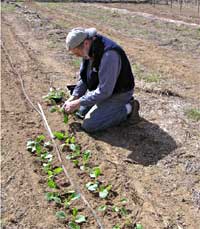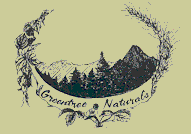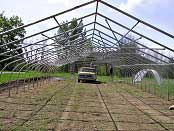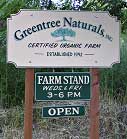 |
 |
 |
 |
 |
 |
 |
 |
 |
 |
|
Greentree Naturals Newsletter Fall 2008
Thom transplanting We are always happy to arrive at the end of the growing season. It really is remarkable that northern Idaho can produce the bounty that it does when the weather is so extreme. At the beginning of April, when there was still three foot of snow in the gardens, we were looking at previous years of garden records and wondering how we would ever catch up. Mother Nature has a way of making things work out, no matter what. It was a scramble but we managed. Everyone that is a farmer has to take a great leap of faith every year. We never know what the weather will bring us, or what kind of pestilence may come into existence. You just do your best every day and hold to the conviction that a successful harvest will take place. This spring, we had cut worms like we have never seen before. We had crops completely destroyed over night. One day, I was looking at the shallots commenting "it looks like a bumper crop this year", and the next morning having them eaten down to nubs. We were staying up late and going out into the gardens with our headlamps on to hand pick the beastly creatures off our crops. We sprayed BT, Neem, and garlic oil; we dusted with corn meal, we tried everything organic that we could come across, and the cut worms kept coming. This is typically a springtime challenge, and thankfully, as the weather warmed up, our perseverance paid off. We are always learning how to improve our interface with garden pests. Next year, we will be more pro-active and aggressive with early cut worm control. We were pleasantly surprised at the success of harvests since we had such a late start up to the spring and numerous pest challenges. We were able to save just enough of the shallots for seed for next year, and had to replant many vegetables. We still managed to have the most successful year ever, so I guess we are doing something right. We had the best garlic harvest that we have had in years, and over all yields were up on almost everything in the gardens. We are changing quite a few of our fertilizing techniques primarily due to cost increases for supplemental items that we typically use. The state of the economy has forced us to be more sustainable and this has actually turned out to be a positive transition for us. We are using less off farm inputs, and expanding our composting system. Needless to say, it takes an incredible amount of compost and manure to feed our growing area, but we are getting better at composting and soil improvement every year. These economic times have forced everyone to take a serious evaluation of how we are spending our hard earned dollars. I haven't seen the farmers market this busy since the 9/11 event. Customers are hungry for a local food supply and want to know their farmer. This is a great time for building local food systems because everyone is thinking about ways to be more sustainable in their communities as well. Connecting with your local farmer is about the smartest thing anyone can do where they live. No matter what happens with the economy, the closer to home your food supply is, the healthier it is for you.
Summer events: We hosted another Organic wine tasting in late July that was well attended, hosted a farm walk for a group of teenagers from the Monarch School in Montana who were here to learn about organic gardening, and had 46 participants come for a farm tour and treasure hunt with the Homeschoolers of Bonner County. The treasure hunt was a search to find different colors of vegetables. The Pumpkin Project was completed when 36 first and second graders returned to the farm to harvest their pumpkins. We also were open by appointment for local kids to come out and harvest pumpkins on the farm. I started teaching the Sustainable Small Acreage Farming and Ranching Course on October 21st this fall. I contract with University of Idaho as an instructor for this program. We meet one night a week for 12 weeks. It is very satisfying being involved with something that is growing new farmers. So much farmland is being lost to housing developments, which facilitates the need for more small acreage producers to find their niche. Teaching and sharing information has become such an important part of my life. My two favorite things are planting a seed and watching it grow, and empowering others to do the same through educational endeavors. We will spend the winter evaluating our garden records, reviewing harvest records, and making plans for the next rotation on the farm. Every year we learn more about how to be better at what we do. We are always trying new things, and change is an integral part of our success. All the best, Diane
|
2003 Rapid Lightning Road, Sandpoint, Idaho 83864 • 208-263-8957 • info@greentreenaturals.com
Site Design by Logical Expressions, Inc.


 We did finally manage to get the 30'X100' greenhouse framework set up over Memorial Day. My brother Carl came up from Bend and helped Thom with it. We have been researching utilizing a type of thermal heating and cooling system called an earth tube, and now plan on making the entire system an alternative energy structure. This winter, I will spend more time researching and hopefully write a grant to secure funding to complete this project in time to use it in 2009.
We did finally manage to get the 30'X100' greenhouse framework set up over Memorial Day. My brother Carl came up from Bend and helped Thom with it. We have been researching utilizing a type of thermal heating and cooling system called an earth tube, and now plan on making the entire system an alternative energy structure. This winter, I will spend more time researching and hopefully write a grant to secure funding to complete this project in time to use it in 2009. The farm stand was opened for six weeks this summer. When I opened it, I made the commitment to keep it going for at least six weeks, and that is pretty much how long it was open. Hindsight being what it is, we learned a lot and next year, we will be open only one day a week. I purposefully did not advertise, and just wanted to see how well it would work out. Opening day was overwhelming, complete with traffic jams. As the weeks progressed, business was slow, but steady. I obviously wasn't thinking clearly when I decided to be open on Wednesdays and Fridays. I make 22 deliveries on Wednesdays and 5 deliveries on Fridays then spend the rest of the day preparing for the Saturday Farmers Market. Adding the Farm Stand on these two days was a bad idea. So, I learned something and will try it again a different day of the week. We met lots of new neighbors and had tremendous community support.
The farm stand was opened for six weeks this summer. When I opened it, I made the commitment to keep it going for at least six weeks, and that is pretty much how long it was open. Hindsight being what it is, we learned a lot and next year, we will be open only one day a week. I purposefully did not advertise, and just wanted to see how well it would work out. Opening day was overwhelming, complete with traffic jams. As the weeks progressed, business was slow, but steady. I obviously wasn't thinking clearly when I decided to be open on Wednesdays and Fridays. I make 22 deliveries on Wednesdays and 5 deliveries on Fridays then spend the rest of the day preparing for the Saturday Farmers Market. Adding the Farm Stand on these two days was a bad idea. So, I learned something and will try it again a different day of the week. We met lots of new neighbors and had tremendous community support.